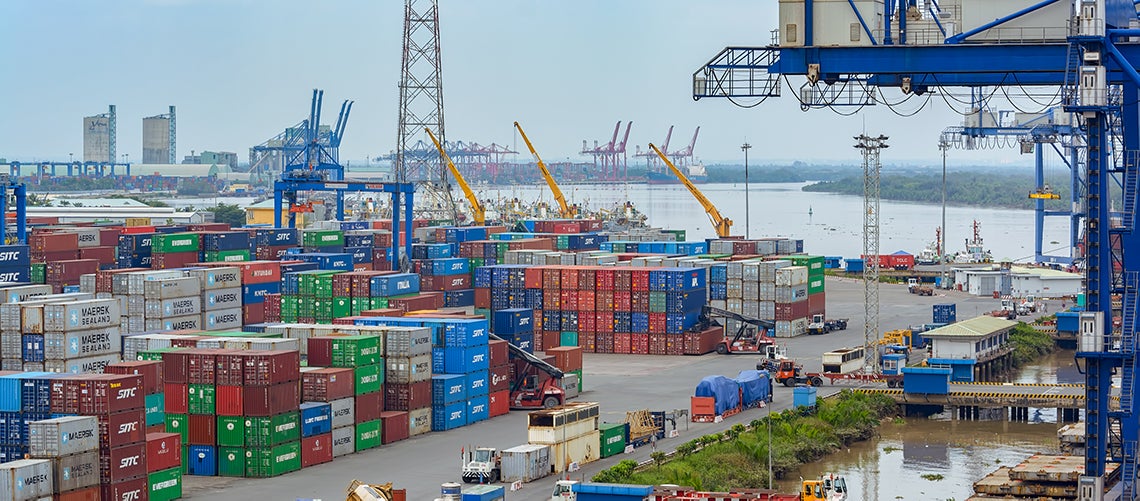 Operations on the Saigon Newport Corporation (SNP) container terminal in Vietnam. Credit: Igor Grochev/Shutterstock.com
Operations on the Saigon Newport Corporation (SNP) container terminal in Vietnam. Credit: Igor Grochev/Shutterstock.com
But COVID-19 poses unprecedented challenges to global value chains by disrupting both the supply of goods and also the demand for them. How has the coronavirus pandemic affected firms in developing countries that are engaged in global value chains? How are firms adapting to the new normal? What is the role for policy?
While experiences may vary by country, governments and firms in developing countries can learn from one another as good practices and policy lessons emerge. A recent conversation on Ethiopia and Vietnam brought together representatives of governments and businesses in these two countries to address exactly those three questions.
How has the pandemic affected firms in developing countries that are engaged in GVCs?
The pandemic has led to widespread disruptions to GVCs. In Ethiopia, the fall in consumer demand for clothing and the closure of retail stores in high-income countries has significantly hit apparel and textile suppliers. The impact has not been the same across the industry. Firms focusing on sporting goods are bouncing back, as containment measures are lifted and stores in key markets are reopening, while firms that provide formal attire remain subdued.
In Vietnam, electronics value chains have been impacted by lockdowns of overseas suppliers and disruption to logistics services, affecting both shipping of raw materials and electronic components – and delivery of final products to consumers.
These disruptions have highlighted drawbacks of long-distance supply chains. For example, traditional apparel businesses sourced fabrics from Asia, turned them into garments in other countries, and then shipped them to the U.S. or Europe. These long supply chains can slow the ability of firms to respond rapidly to the crisis and leave firms with piles of costly inventory.
The pandemic has thus provided new impetus to developing a more flexible and agile production network, accelerating ongoing trends of reorganizing GVCs with rising protectionism. GVCs are built on long-term relationships between lead multinationals (MNEs) and their key suppliers. Lead firms have a keen interest in keeping their core suppliers in business.
For many MNEs, the pandemic has made it clear that it can be helpful to move the various components of their business closer to one another, in order to develop and maintain a more sustainable and resilient production network. Indeed, the panel discussed steering GVCs in the direction of local-to-local, with supply chains closer to the retail market. MNEs are shortening the distance between suppliers and customers and becoming more vertically integrated with a view to improve production flexibility and operate more sustainably.
How are firms adapting to the new normal?
The pandemic offers opportunities, including re-balancing towards local economy.
Some firms are adapting their business models in response to the crisis. As we heard during the panel discussion, Ethiopian Airlines has adapted to lower passenger numbers by repurposing passenger planes for cargo. Firms in Ethiopia’s industrial parks have retooled to manufacture personal protective equipment (PPE). Other firms are responding by refocusing on their core products and key suppliers.
COVID-19 has also accelerated the trend of digitalization. For instance, the lockdown of workers might raise incentives for companies to automate certain functions, encourage digitalization and use of online platforms. Containment measures that limit mobility encourage use of online sales and boost e-commerce, which allow firms to reach new consumers for goods and services. The use of 3D printing has received new impetus, as it can shorten supply chains and speed time to market. Some of these changes predate the pandemic, but they are now being fast-tracked to help businesses better adapt to the new normal.
Apparel supply chains are becoming more responsive and environmentally sustainable – by bringing more stages of production to the same location. However, a key challenge is coordination with other firms along the value chain and with the government. Leveraging economies of scale requires large supplier investments, which may only be possible when several lead firms coordinate their demand.
What is the role for policy?
Ethiopia and Vietnam have both launched support programs to help firms stay open. Such policies also aim to prevent the loss of important supply chain relationships and the skills and know-how that firms have acquired through GVCs. As Vietnamese policymakers emphasized, prosperity hinges on long-term competitiveness and sustainability achieved by improving productivity of local enterprises.
Policy will continue to play a key role in helping firms adapt to new business models. For example, trade frictions can be mitigated through deep trade agreements that cover not just trade but additional policy areas, such as the protection of intellectual property rights and the environment, as in Vietnam with CPTPP and EVFTA. Supply networks can be expanded and strengthened through policies that promote digital business-to-business (B2B) matchmaking tools, skills and capacity building, and complementary logistics infrastructure. Going forward, a coordinated approach between government and the private sector is likely to be even more important. Such coordination can help developing countries promote technology adoption and diffusion, build the capacity of local firms, and implement new strategies for attracting foreign direct investment (FDI) – especially from firms that add value to local supply chains.
The shift toward more sustainable and resilient GVCs has been at the core of discussions among government and business leaders in the time of COVID-19. The pandemic may catalyze supply-chain changes that were already underway – by promoting near-shoring and regionalizing of supply and production networks, more extensive digitalization, and more sustainable production networks and practices. Leading firms, local suppliers, and policymakers all have a key role to play to facilitate these changes while promoting the creation of more and better jobs.
Replay event: Global Value Chains in the Time of COVID-19: The Experience of Ethiopia and Vietnam







Join the Conversation